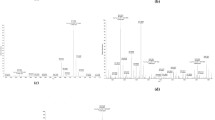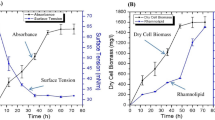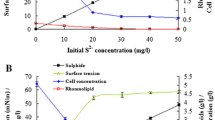Abstract
Naturally occurring methane gas hydrate is a vast source of methane gas which is trapped in crystalline ice-like structure present in permafrost regions and under the sea in outer continental margins. It is purposed that total amount of carbon in the form of methane hydrates is almost twice the carbon content in all the fossil fuel reserves put together, and hence these are supposed to be the future potential energy resource. This paper investigates the laboratory investigations on effect of a biosurfactant rhamnolipid on methane hydrate formation kinetics. Rhamnolipid was produced by Pseudomonas aeruginosa strain A11. The presence of P. aeruginosa has been reported in Gulf of Mexico gas hydrate samples. Biosurfactant reduced the surface tension of water from 72 to 36 mN/m with CMC of 70 mg/L. The biosurfactant dose is studied at two different concentrations in the solution at 100 and 1000 ppm. Kinetic of hydrate formation and growth is compared at 0, 100, and 1000 ppm of rhamnolipid showing that rhamnolipid acts as a hydrate promoter at these concentrations. Thus, small dosages of rhamnolipids produced by P. aeruginosa strain A11 must clearly affect the gas hydrate formation kinetics in natural sites (as in Gulf of Mexico).
Access provided by Autonomous University of Puebla. Download conference paper PDF
Similar content being viewed by others
Keywords
1 Introduction
Methane hydrates are inclusion compounds formed by water and methane at high pressure and low temperature (Sloan and Koh 2007). They are present in sedimentary deposits in permafrost regions and beneath the sea in outer continental margins (Kvenvolden 1993; Paul and Dillon 2000; Hester and Brewer 2009). One volume of gas hydrates releases about 160 volumes of methane at standard temperature and pressure (STP) (Kvenvolden 1993). It is estimated that carbon bound in methane hydrates is twice the carbon content in fossil fuel reserve, and hence these are supposed to be the future potential energy resource. The worldwide assessment of (Kvenvolden 1998a) methane hydrate is equivalent to 250 trillion cubic meters of methane gas. The amount of hydrate bound methane gas is approximately 100 times as large as that of conventional natural gas resource. As per the USA department of energy, if only very small amount of the methane stored in these hydrates could be exploited, it would be almost twice the current domestic supply of natural gas (Haq 1998; Holder et al. 1987). They are also seen as future technology for storage and transportation of gas.
1.1 Energy Potential of Gas Hydrates
The amount of methane caught in gas hydrate is not certain. Various groups have given various amounts of methane trapped in global gas hydrate deposit ranging from ~1017 ft3 or 105 trillion cubic feet (TCF) (Mciver 1981) to 108 TCF (Trofimuk et al. 1977; Kvenvolden 1988, 1998b; Gornitz and Fung 1994; Harvey and Huang 1995). Recently in review on the concerned subject by (Boswell and Collett 2011), the amount of methane caught in gas hydrates has been estimated around 105 TCF (Boswell and Collett 2011). As per the idea of USA department of energy, even negligible amount of methane stored in hydrates can be exploited. It is more than the current supply of natural gas in the country (Holder et al. 1987; Haq and Boulder 1998). Methane hydrates can be assumed upcoming source of hydrocarbon energy and will be a future fuel (Paul and Dillon 2000; Kvenvolden and McMenamin 1980).
2 Present Study
This paper investigates the effect of a biosurfactant rhamnolipid on methane hydrate formation kinetics in laboratory. Rhamnolipid was obtained from P. aeruginosa strain A11. The presence of P. aeruginosa has been reported in Gulf of Mexico gas hydrate samples (Lanoil et al. 2001) which helped in generating rhamnolipids at the site. Methane hydrate formation experiments were performed with 90 % saturation of distilled water (and water–surfactant solution) in porous C-type silica gel (pore volume 0.90 cm3 g−1). The study is carried out in high-pressure vessel maintained at low temperature.
3 Experimental Setup, Materials, Procedure
3.1 Apparatus
Video hydrate cell was used to study the gas hydrate formation which is a mercury-free cell. It can measure the induction time for formation of hydrates and monitor the pressure drop as a function of time during hydrate formation. The system consists of constant volume hydrate cell having capacity of 250 cm3 and pressure rating up to 3000 psi. The temperature is controlled by the thermostatic bath. A computer is attached for data acquisition of temperature and pressure versus time. The diagram of the gas hydrate cell is shown in Fig. 1.
3.2 Materials
Pure methane with 99.99 % pure methane (Chemtron Science Laboratory, Navi Mumbai, India), reverse osmosis water (Millipore SA, 67,120 Molshein, France), C-type silica gel (Merk Merck Specialities Pvt. Ltd., Mumbai, India), and rhamnolipid synthesized in laboratory from strain A11 were used for the experiment.
3.3 Procedure
First, 90 % saturated C-type silica gel was used for experiment; then 90 % saturated C-type silica gel with 100 ppm rhamnolipid aqueous solution and then 1000 ppm rhamnolipid aqueous solution was used for the experiment. The test sample was placed in hydrate cell and constant temperature was maintained immersing the cell into a temperature-controlled bath. A mixture of water and ethylene glycol (25 %) was used as a liquid for bath. A vacuum pump was used to remove the air from the cell before pressurizing methane gas in the cell. The cell was pressurized up to the desired value with methane gas. Sudden pressure decline was observed for the hydrate formation and online video picture was also seen for identifying hydrate formation. When noticeable pressure drop is not observed, it signifies the completion of process of formation of hydrates. The induction time, moles of gas consumed, and rate of hydrate formation were calculated from the obtained pressure temperature date.
4 Results and Discussion
The results obtained in the present study are discussed as follows.
4.1 Induction Time
The induction time, t i, is the passed from the beginning of the experiment at t s to the onset of hydrate formation t o and it is one of the kinetic parameters of hydrate formation. The induction time for various experimental conditions is given in Table 1, and the moles of methane consumed are shown in Fig. 1.
It can be concluded from Table 1 that the induction time in the presence of 100 ppm rhamnolipid has been reduced which states that rhamnolipid is acting as promoter for the formation of methane gas hydrates.
4.2 Moles of Gas Consumed
While the hydrate is formed, the drop of pressure was observed, which is due to the consumption of gas of methane. The methane takes over the unoccupied cavities of water while hydrate formation. The amount of gas consumed during hydrate formation can be calculated by real gas equation:
where n is the amount of gas consumed when hydrates form, V is the gas volume, P i, T i and P f, T f are the pressure and temperature at initial and final conditions, and R is the universal gas constant. Compressibility factors (z i, z f) are calculated at the corresponding pressure and temperature, respectively. The pattern of gas consumed during formation of hydrate is shown in Fig. 2.
As it is evident from Fig. 2 that maximum numbers of moles are consumed for 1000 ppm rhamnolipid, at lower dose, i.e., at 100 ppm, the number of moles of methane gas consumed is lesser than without rhamnolipid but as the concentration of rhamnolipid is increased than amount of methane gas consumed is more than that of without rhamnolipid.
Figure 3 shows the consumption of gas and pressure drops as a function of time. The growth and gas consumption regions show the two symmetric plots that could be explained as conservation of mass during the hydrate growth. Pressure drop shows the number of methane molecules leaving the gas phase to hydrate phase drop, whereas gas consumption plot shows the number of methane molecules entering into the hydrate cages. Mass remains conserved in an isochoric system, which is shown by the symmetry of the two plots about an axis passing through the intersection of the two plots and parallel to the time axis. As shown in Fig. 3, the process is splitted into three regions. First region starts at time zero where the consumption of the gas is less in the system and pressure slightly decreases because of dissolution of gas. Second region is after the induction time where gas consumption is increased; this happens because of the hydrate growth. In third region as the hydrate is formed, gas consumption is as shown in Fig. 3.
4.3 The Rate of Methane Hydrate Formation
As seen from Fig. 4, the slope of the curves after nucleation indicates an exponential behavior from which we can assume a first-order reaction. Equations 2 and 3 can be used for a first-order reaction which is defined as follows:
where N is the total number of moles at time t, N 0 is the initial number of moles, k is the rate constant (min−1), and t is the time in minute. The rate constant (k) of hydrate formation can be calculated from the slope of the curve of ln (N/N 0) versus time. The hydrate formation from region 2 onward Fig. 3 was divided into five zones of time as shown in Fig. 5 (0–20, 20–40, 40–80, 80–160, 160–260 min) after nucleation. The data of these five zones are used to determine the rate constant of hydrate formation in each zone. Hydrate formation rate is determined by putting the values of slopes, i.e., rate constant k calculated from Fig. 4 in the following equation:
The values of rate constant and concerned rates obtained in present study in the presence of 100 ppm rhamnolipid are shown in Table 2.
The above results indicate that rhamnolipid acts as promoter for the methane hydrate formation. It is also observed that the induction time of hydrate formation is reduced in the presence of rhamnolipid (Table 1). The rate of hydrate formation is found to increase many time (Table 2).
The zeta potential of rhamnolipid synthesized in the present study from strain A11 was found to be negative; hence, it is anionic surfactant and much of work in literature on anionic surfactants such as SDS, etc. on gas hydrate formation has been reported. These results are in agreement with various studies reported on synthetic anionic surfactants like SDBS (Dai et al. 2014) ans LABS (Ganji 2007; Fazlali et al. 2013; Kumar et al. 2014).
The rhamnolipid acts as a promoter as the biosurfactant spherical micelles are formed by long-chain carbon alkyl groups which solubilize hydrocarbon gases (MacKerell 1995).
The above results indicate that rhamnolipids act as promoter which can help in synthesizing gas hydrates. Industries looking upon gas hydrates not because of their energy potentials rather it is becoming a technology these days because of their other applications such as transportation and storage of gas, desalination of water, etc. The present study clarifies the role of rhamnolipid a biosurfactant as promoter in natural sites and giving a green biodegradable promoter as much of work as promoter of gas hydrates is reported on synthetic surfactants; however, the study has given a replacement of synthetic surfactant by a green biosurfactant.
5 Conclusion
The above study clearly indicates the role of rhamnolipid in the formation of methane gas hydrate formation as promoter; thus small dosages of rhamnolipids produced by P. aeruginosa strain A11 must clearly enhance the gas hydrate formation kinetics in natural sites (as in Gulf of Mexico). Rhamnolipid is a green biodegradable promoter for gas hydrates formation, and is a green bio-surfactant which can substitute the synthetic surfactant which is used presently as promoter for the formation of gas hydrates.
References
Boswell R, Collett TS (2011) Current perspectives on gas hydrate resources. Energy Environ Sci 4:1206–1215
Dai Y, Zhong X, Jiang X, Wang S (2014) Experiment of new additives effect on gas hydrate formation. Energy Power Eng 6:133–141
Fazlali A, Kazemi S-A, Moraveji MK, Mohammadi AH (2013) Impact of different surfactants and their mixtures on methane-hydrate formation. Energy Technol 1:471–477
Ganji H, Manteghian M, Sadaghiani ZK, Omidkhaha MR, Mofrad RH (2007) Effect of different surfactant on methane hydrate formation rate, stability and storage capacity. Fuel 86:434–441
Gornitz V, Fung I (1994) Potential distribution of methane hydrates in the world’s oceans. Glob. Biogeochem Cycles 8:335–347
Haq BU (1998) Gas hydrates; greenhouse nightmare? Energy panacea or pipe dream. Geol Soc Am (GSA) Today 8(11):1–6
Harvey LDD, Haung Z (1995) Evaluation of the potential impact of methane clathrate destabilization on future global warming. J Geophys Res 100(D2):2905–2926
Hester K, Brewer PG (2009) Clathrate hydrates in nature. Ann Rev Mar Sci 1:303–327
Holder GD, Malone RD, Lawson WF (1987) Effects of gas composition and geothermal properties on the thickness and depth of natural-gas-hydrate zones. J Petrol Technol 39(9):1147–1152
Kumar SV, Kumar MG, Udayabhanu G, Mandal A, Laik S (2014) Kinetics of methane hydrate formation and its dissociation in presence of non-ionic surfactant Tergitol. J Unconventional Oil Gas Resour 54–59
Kvenvolden KA (1988) Methane hydrate—a major reservoir of carbon in the shallow geosphere. Chem Geol 71:41–51
Kvenvolden KA (1993) Gas hydrates—geological perspective and global change. Rev Geophys 31:173–187
Kvenvolden KA (1998a) A primer on the geological occurrence of gas hydrate. Geol Soc Lond Spec Pub. 137:9–30
Kvenvolden KA (1998b) Estimates of the methane content of worldwide gas-hydrate deposits, methane hydrates: resources in the near future. Paper presented at JNOC-TRC, Japan. 20–22 October
Kvenvolden KA, McMenamin MA (1980) Hydrates of natural gas: a review of their geologic occurrence. US Geol Surv Circ 825:1–11
Lanoil BD, Sassen R, La Duc MT, Sweet ST, Nealson KH (2001) Bacteria and Archaea physically associated with Gulf of Mexico gas hydrates. Appl Environ Microbiol 67(11):5143–5153
MacKerell AD (1995) Molecular dynamics simulation analysis of a sodium dodecyl sulfate micelle in aqueous solution: decreased fluidity of the micelle hydrocarbon interior. J Phys Chem 99:1846
Mciver RD (1981) Gas hydrates In: Meyer RF, Olson JC, Long-term energy resources, Pitman, Boston, pp 713–726
Paul CK, Dillon WP (2000) Natural gas hydrates occurrence, distribution and detection. Am Geophys Union Geophys Monogr 124:315
Sloan ED, Koh C (2007) Clathrate hydrates of natural gases, 3rd edn. CRC Press, Boca Raton
Trofimuk AA, Cherskii NV, Tsaryov VP (1977) The role of continental glaciation and hydrate formation on petroleum occurrence In: Meyer RF, The future supply of nature-made petroleum and gas. Pergamon Press, New York, pp 919–926
Acknowledgments
The supports from institutes namely National Chemical Laboratory (CSIR Laboratory), Maharashtra, Pune, India, Institute of Microbial Technology (CSIR Laboratory), UT, Chandigarh, India, Keshav Dev Malviya Institute of Petroleum Exploration, Oil and Natural Gas Corporation (ONGC), Uttrakhand, Dehradun, India. Indian School of Mines, Jharkhand, Dhanbad, India are highly acknowledged.
Author information
Authors and Affiliations
Corresponding author
Editor information
Editors and Affiliations
Rights and permissions
Copyright information
© 2016 Springer India
About this paper
Cite this paper
Amit Arora et al. (2016). Role of Rhamnolipid: A Biosurfactant in Methane Gas Hydrate Formation Kinetics. In: Kumar, S., Khanal, S., Yadav, Y. (eds) Proceedings of the First International Conference on Recent Advances in Bioenergy Research. Springer Proceedings in Energy. Springer, New Delhi. https://doi.org/10.1007/978-81-322-2773-1_25
Download citation
DOI: https://doi.org/10.1007/978-81-322-2773-1_25
Published:
Publisher Name: Springer, New Delhi
Print ISBN: 978-81-322-2771-7
Online ISBN: 978-81-322-2773-1
eBook Packages: EnergyEnergy (R0)









